Mountain cheese at a Planina in Bohinj, Slovenia
Transhumance, milking and herding cows, and my peak butter high.
I’d like to look back at a memorable experience I had in September of 2021, in the early days of Milk Trekking, when it was just me, a greasy backpack, and an urge to taste mountain cheeses while spending time in the places they are made, with the people and animals who make them. I came here after 5 weeks in the Italian Alps, and had no contacts or plans. I had heard of a valley called Bohinj where small scale family dairying is practiced, and a “Cheese Trail” connects small collections of buildings called Planinas, hamlets in an alpine setting where herders milk cows and make cheese in the summer months. So I went to see what I could find.
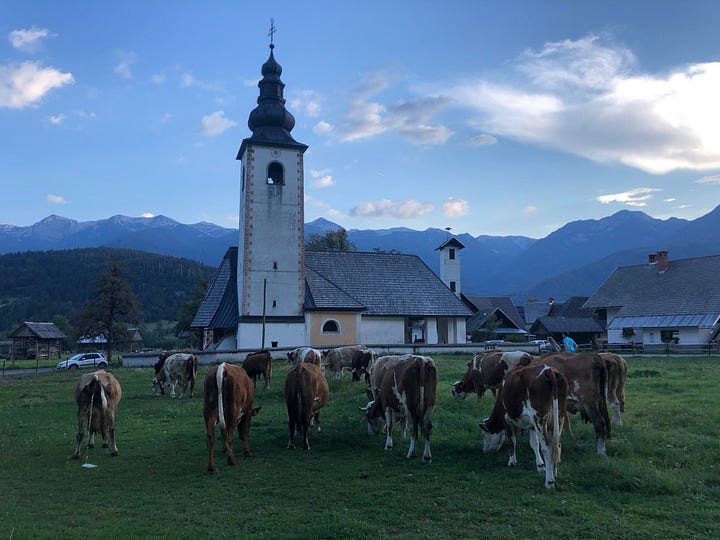
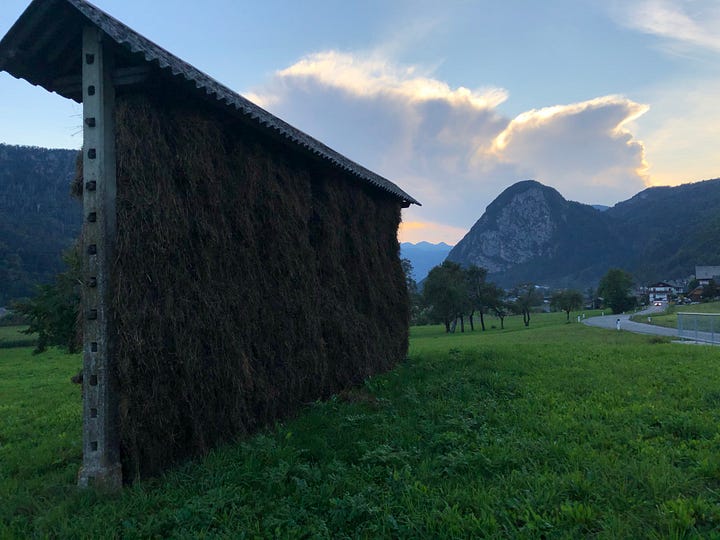
I arrived by train from Ljubljana and walked through picturesue hayfields, visiting a well stocked museum dedicated to the history of the region’s dairying and transhumance. The woman who ran it gave me the name of a Planina that could possibly show me the traditional practices that I seek to observe and participate in.
Krstenica.
Kristen Nietzsche is how anglicized the name to remember the pronunciation. I repeat the name now, a mantra, which recalls one of the more impressive and serendipitous visits of my 16 month journey.
I walked up a mountainside, repeating the name in case I needed to ask any passersby for directions. Kristen Nietzsche.....Kristen Nietzsche..... I could see it on a map, amongst a network of trails that allow tourists to visit peaks, and have comfortable stays at the guesthouses in old wooden buildings in the painfully picturesque Planinas. As I neared, I heard cowbells and someone chopping wood. I was slightly apprehensive, not wanting to spoil the tranquility and cool mountain air with my presence. But here I was. Committed to intrusion. Letting my feet do the walking. My heart telling my mind to stop worrying.
I walked up and clumsily said hello, one of the few words of Slovenian I knew. A young man, Mitja, looked me over and said hello briskly, speaking in jolting English. I explained that I was interested in seeing how they made cheese, and that I was hoping to spend time volunteering on a Planina. He told me to sit, and then brought me a tea and began chopping again. I took in the spectacular view, and enjoyed the tangibly nourishing quality of the air. Eventually another man came, Marko, who shook my hand warmly, asking me about my background. He had a short conference with the Mitja, and they told me I could stay and work with them for the final ten days of the summer grazing season.
That was easy.
It was a lesson on allowing things to unfold naturally. Trust the Journey.
“I told you so” my heart remarked.
Let your feet do the walking, your heart do the talking.
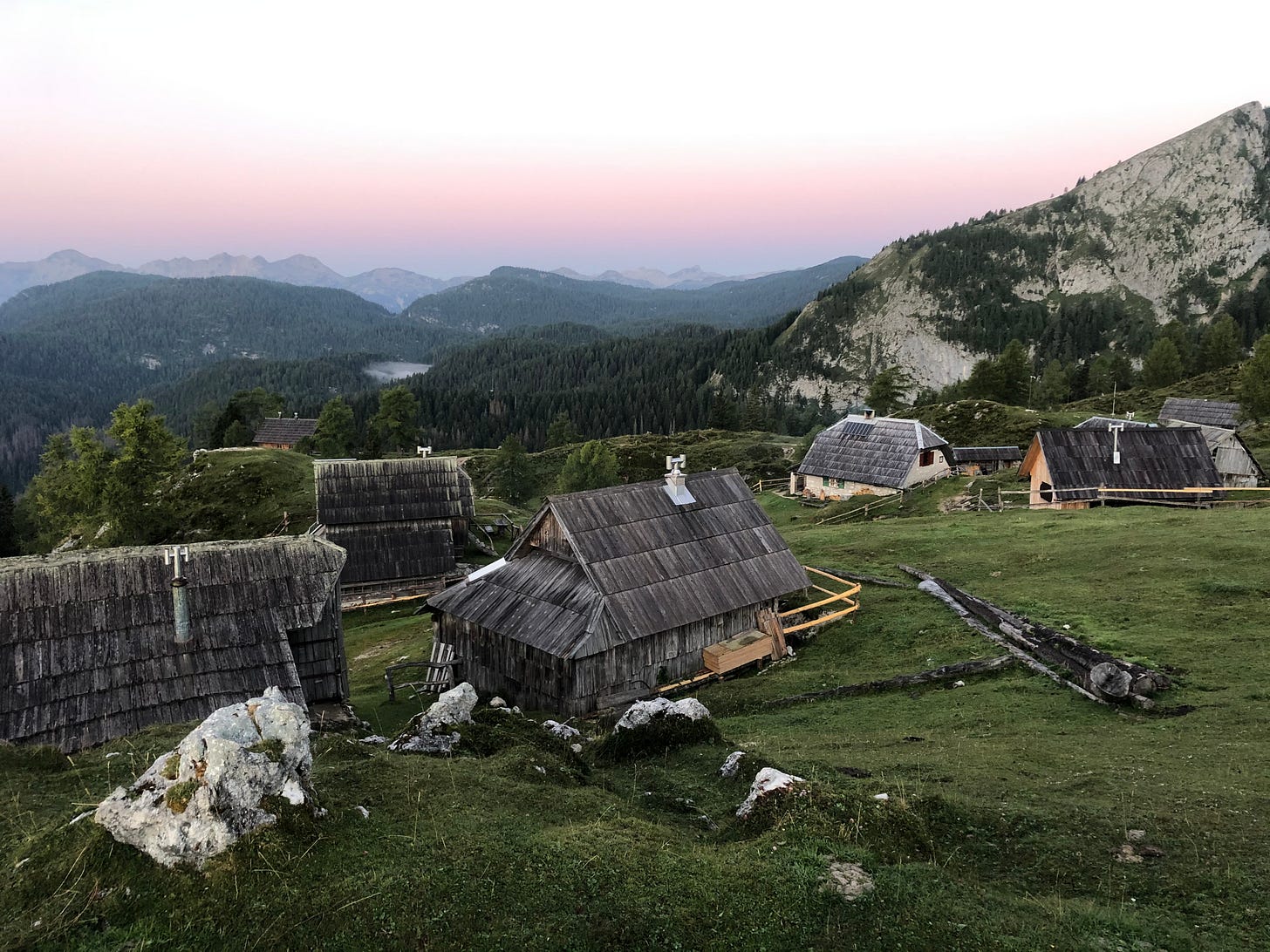
Marko showed me to a bed in a communal bunk-room in the attic of a large, quaint building, one of about 12 in this planina built just above treeline. While many planinas have moved in the direction of guesthouses and rentals for tourists, Krstenica was known for being one of the last to practice the traditional system of summer dairying and cheesemaking, without tourist trappings. The farmers of two villages in the valley had rights to graze the pastures, and maintain their familial buildings. Marko and Mitja were not from this region, but were contracted as herder/cheesemakers, coming up with the pooled herd from the village, which consisted of 16 milking cows.
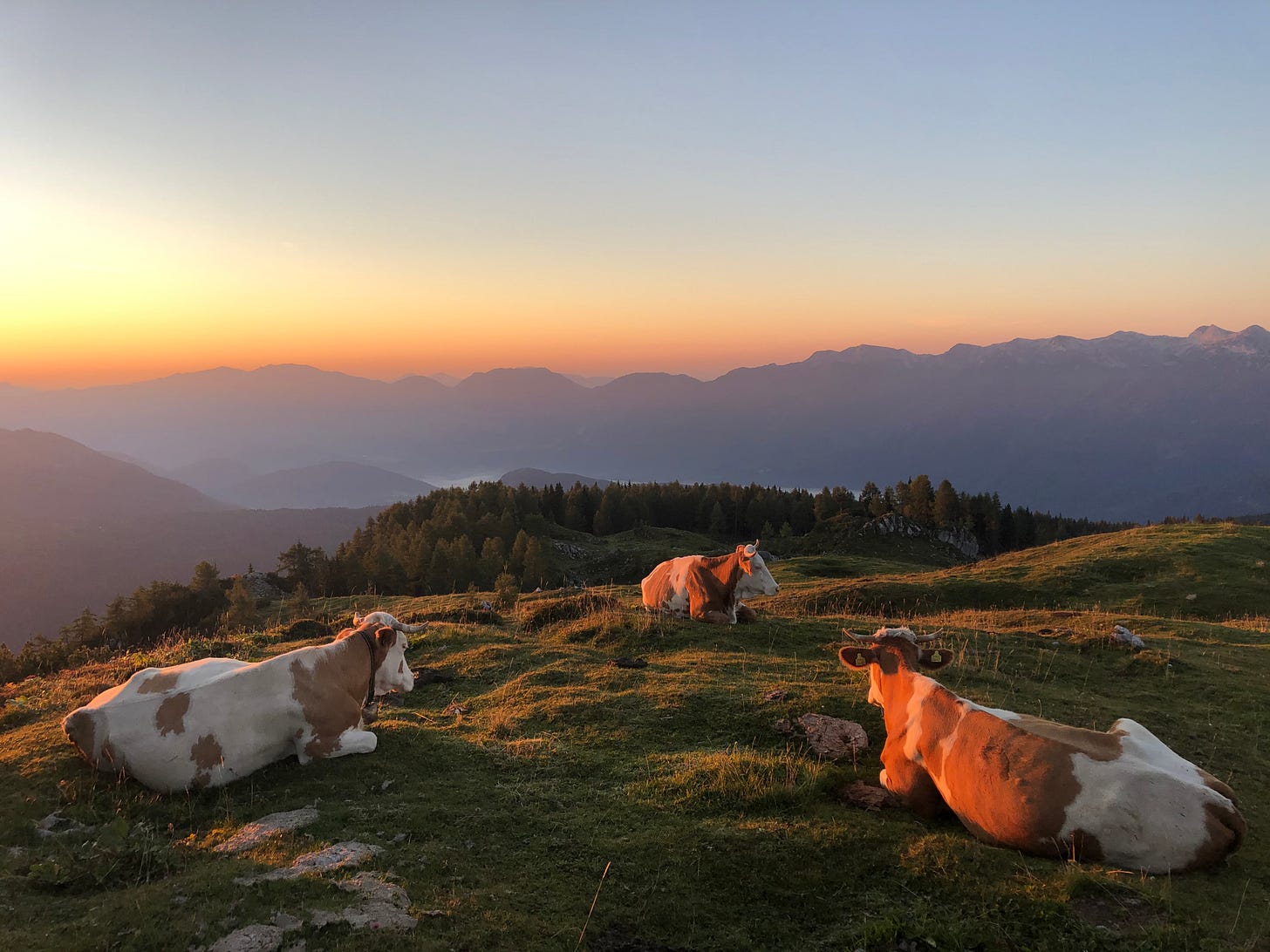
They woke me well before sunrise the next morning, with hot coffee, bread, jam and butter. Marko and I went out to find the cows, who bed down where they choose on the open pastures. It was good to catch them before they rose, Marko told me, before they wandered off in search of feed. This idea of searching for sleeping cows excited me. Like giant ruminating easter eggs, they could lay silently bedded down, hard to find amongst the trees. We heard a bell sound lazily uphill, and there they were, sleeping on small shelves perched on a stupendous hillside as the burning star began melting the chill from the air. They rose and stretched slowly, seeming to understand the drill as they sauntered down with minimal prodding, back towards the planina hamlet where wood smoke completed the fairy tale ambiance.

The cows filed into a milking shed, each going to its customary place. They were milked via a vacuum pump into a tall milk bucket, which was carried into the creamery. The milk was weighed and then poured into a copper vat. There is no refrigeration of milk here, and I now see how that is a major factor in why the cheese and other milk foods made here are of such high quality. Evening milk was left to sit in buckets inside the cool creamery. In the morning this cream is skimmed off and put in a large bucket in a cool space, where it would sour slowly. Hand skimming results in a not fully skim milk, with I would imagine between 1.5 and 2% fat remaining in the milk. This partially skimmed evening milk is added to whole, udder warm morning milk, and the mixture heated with a fire burning in an enclosed space under the copper vat. House-made sour milk or store bought yogurt are added as a starter, and the vat is set with calf rennet. Once the curd has barely set into a thick pudding, it is cut with the wire harp characteristic of the Alpine Technique that Swiss people have introduced around the world in a phenomenon I call Alpine Evangelism.

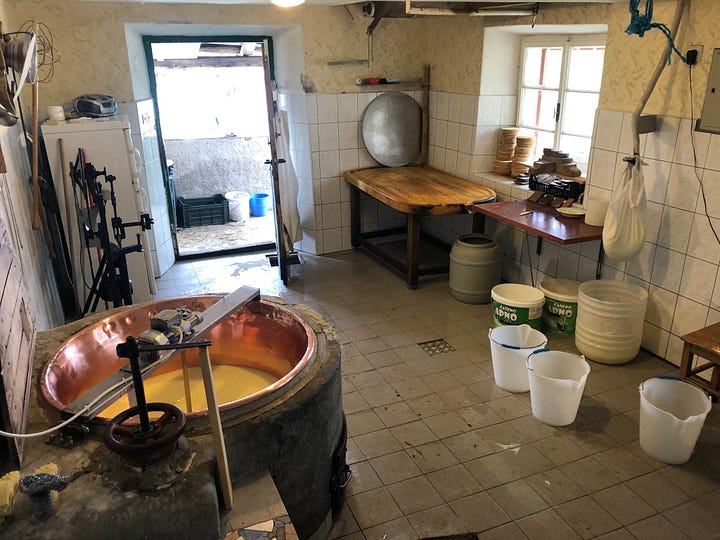

The curd is cooked rapidly to a temp of 113, putting it firmly in the range conducive to fermentation by thermophilic bacteria. I don’t think this makes it soley thermo though, as I now conceive of most cheeses as being mixed fermentations. The cheese rapidly cools back down below 100, and I imagine mesos kick back in, and the microbes living on the wood press, which definitely include yeasts, begin working their magic on a wheel that will undergo various stages of exchange with a multitude of microbes. Life never takes place in isolation. The attempts to make cheese in a vacuum have resulted in cheeses that suck, tend to be consistently mediocre, and have flavors that match how they are made. Vacuous.
What I found here was the opposite. The cheese made at Krstenica is profoundly unique and beautiful, a reflection of the place in which it is made, and a culture that clings stubbornly to the old ways. It is generally referred to as Bohinjski Sir, (cheese from Bohinj), but I prefer to call it Krstenica Sir.
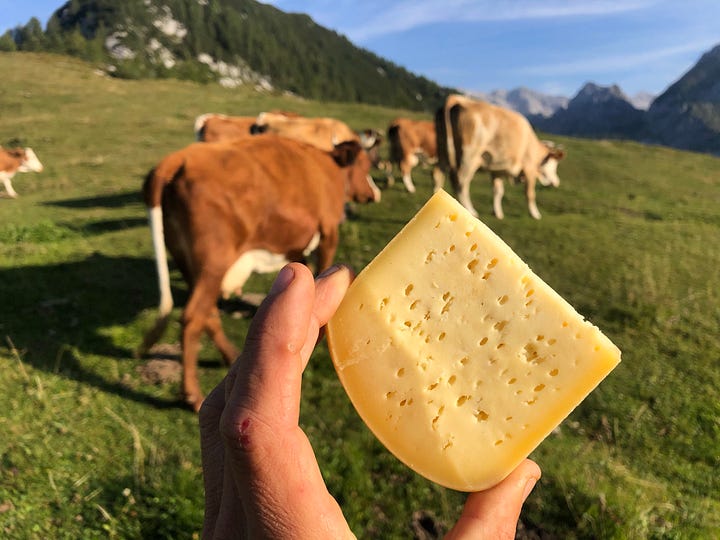

A particular aroma is etched in my memory. I first noticed it in both the cheese and a thick sour milk beverage served at breakfast. Then I noticed it coming from the body of a cow, and permeating the wooden posts of the milking barn. It is a yeasty, sour milk and cow aroma, with a malty aspect I associate with naturally fermented cheeses. What I sensed was a distinct and signature variation of this profile, and one of the more profound instances of terrior in cheese that I have experienced. This was evidence supporting a concept I was exploring, that the flavors of a cheese begin to form before the milk gets into the vat. That the whole farming system, combining human cultural practices, the genetics and biology of livestock, their feed and sleeping conditions, the soil, weather, and microbial ecology of a place can shape the outcome. You can sometimes taste this puzzle of factors in a cheese, if we let them into the process, rather than attempting to shut them out.

For me, the proof is in the wheel. A small round with semi firm, highly pliable paste. They only age them 3-6 weeks, and they have a remarkable amount of flavor at this stage. A hint of olives, along with other aspects of Fontina, the cheese I had just focused on that is made in a similar manner, cooked to exactly the same temp in a copper vat. A very pleasant and complex yeasty profile, which I clearly perceived when entering the creamery, emanating from the wood press upon which the cheeses sat over night as they cooled, being “contaminated” by a biofilm that thrives on a porous surface that can never be sterilized. Sterilization is a fantasy. Contamination is another word, for life.
The butter was the best I have ever had. The unrefrigerated, biologically active milk from a small, healthy herd eating a diversity of uncultivated plants, drinking pure mountain water, is a major component. What I am surprised to add is that the devise used to churn the cream into butter is also a likely factor. It was an old fashioned wooden plunger churn, that had a belt driven motor attached to accomplish the laborious 15-20 minutes of plunging. The sound would change as the cream was transformed, and eventually butter could be heard congealing into a mass, with buttermilk squirting out a small deliberate hole in the lid. The butter was removed and washed in cold creek water, then pressed into wooden molds. It is a drug. I could not get enough, and it was all sent down to the farmers so I only had a few bites here and there. Words can only miss the mark, of the mystical nature of this alchemical golden distillate. It’s the peak butter experience that I compare all others too, a paradigm shifting moment.
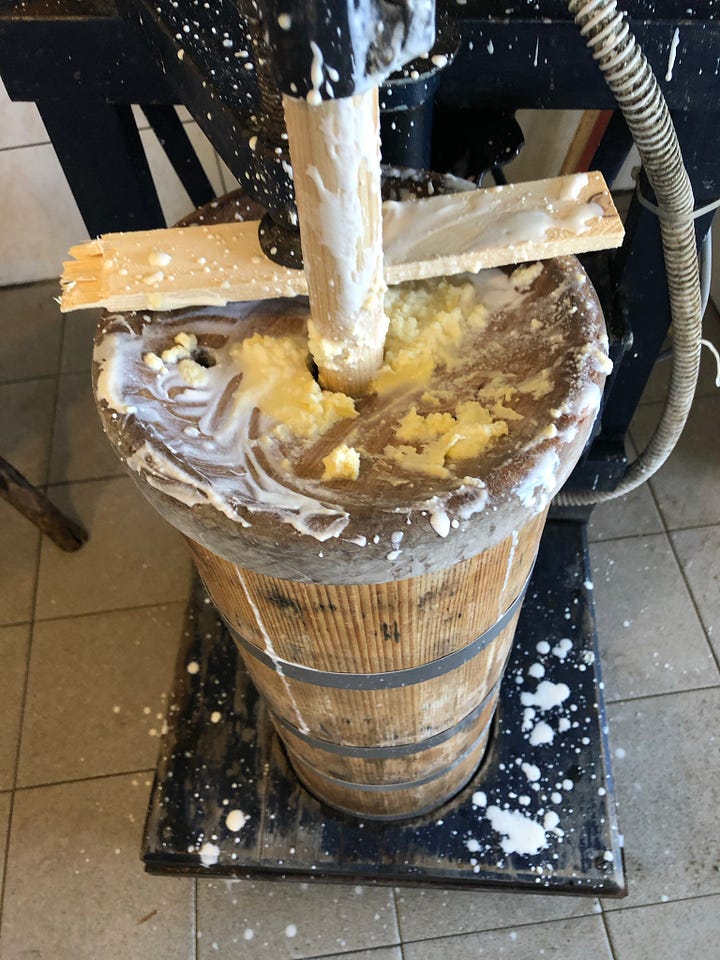

The ten days spent at Kristenica were a high moment of my travels. But what goes up must come down they say. A very linear, and therefore limited model of life, but often an apt aphorism. The summer season ended with the cows being brought down by the families, a festive mood with jovial hooting and hollering, children joining to chase calves out of the brush. It is a half days walk down trails and roads to the valley bottom where the cows branch off as they come to their homes, and are tied in the basement stalls where they will spend the winter. As the last cows went away, the sunset with a chill, and I walked on with my backpack and heart filled with cheese and memories.




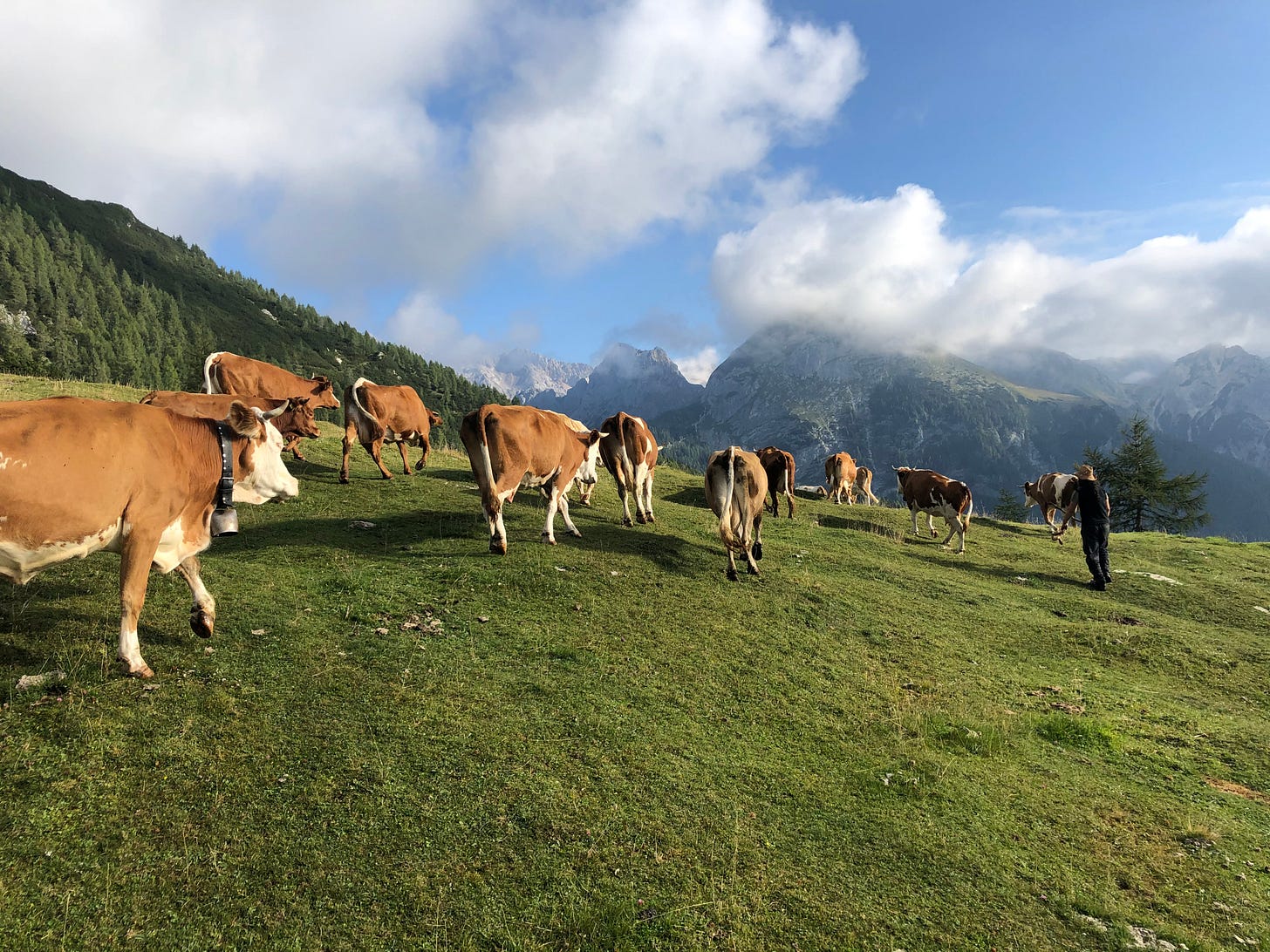

This is poetry plus science. A call to respect nature plus permission to experiment. I love all of those aspects. I will be heeding the call.
Thank you.
Always enjoy your posts! While reading about the distinct elements that create terroir in a cheese, I immediately thought of my recent education in smelling and tasting raw fat from our goat we just butchered, and how now I smell that every time I drink milk from our other goat. They were siblings. The animal is intrinsic in all its products. If you're not tasting animal in your food, it is dead food. Love your thoughts that echo all the things I am learning on my own journey as well. Enjoy Norway!!